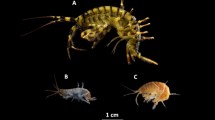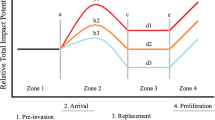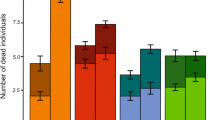Abstract
Deciphering the mechanisms by which climate change interacts with invasive species to affect biodiversity is a major challenge of global change biology. We conducted experiments to determine whether the global invader, Gambusia holbrooki, was more resistant to high water temperature (heat) and low dissolved oxygen (hypoxia) than a threatened native fish, Nannoperca australis. Metabolic experiments conducted at 25 and 29 °C showed that G. holbrooki had at least four times the capacity for metabolic depression during hypoxia than N. australis. An increase in environmental temperature from 25 to 29 °C had no significant impact on the critical oxygen tension, P crit, of G. holbrooki, but significantly and strongly increased P crit of N. australis. Gambusia holbrooki also had a lower Q 10 of standard metabolic rate than N. australis. Our results indicate that G. holbrooki have physiological traits conferring greater resistance to hypoxia than N. australis, and as temperature increases, the resistance of N. australis to hypoxia was more eroded than that of G. holbrooki. Intensive monitoring of the temperature and dissolved oxygen dynamics of wetlands showed that contemporary heat waves are already causing conditions that might give G. holbrooki the edge over N. australis on Australian floodplains. Our study adds weight to recent anecdotal reports of drought and heat waves causing localised extinction of N. australis, but the proliferation of G. holbrooki.





Similar content being viewed by others
References
Alcaraz C, Bisazza A, Garcia-Berthou E (2008) Salinity mediates the competitive interactions between invasive mosquitofish and an endangered fish. Oecologia 155:205–213. doi:10.1007/s00442-007-0899-4
Angilletta MJ, Sears MW (2011) Coordinating theoretical and empirical efforts to understand the linkages between organisms and environments. Integr Comp Biol 51:653–661. doi:10.1093/icb/icr091
Bickler PE, Buck LT (2007) Hypoxia tolerance in reptiles, amphibians, and fishes: life with variable oxygen availability. Annu Rev Physiol 69:145–170. doi:10.1146/annurev.physiol.69.031905.162529
Bond NR, Lake PS, Arthington AH (2008) The impacts of drought on freshwater ecosystems: an Australian perspective. Hydrobiologia 600:3–16
Byers JE (2002) Impact of non-indigenous species on natives enhanced by anthropogenic alteration of selection regimes. Oikos 97:449–458. doi:10.1034/j.1600-0706.2002.970316.x
Chapman LJ, Kaufman LS, Chapman CA, McKenzie FE (1995) Hypoxia tolerance in 12 species of East-African cichlids: potential for low-oxygen refugia in Lake Victoria. Conserv Biol 9:1274–1287
Chapman LJ, Chapman CA, Nordlie FG, Rosenberger AE (2002) Physiological refugia: swamps, hypoxia tolerance and maintenance of fish diversity in the Lake Victoria region. Comp Biochem Physiol A Mol Integr Physiol 133:421–437
Clark TD, Sandblom E, Jutfelt F (2013) Aerobic scope measurements of fishes in an era of climate change: respirometry, relevance and recommendations. J Exp Biol 216:2771–2782. doi:10.1242/jeb.084251
Closs GP, Lake PS (1996) Drought, differential mortality and the coexistence of a native and an introduced fish species in a south east Australian intermittent stream. Environ Biol Fishes 47:17–26. doi:10.1007/bf00002376
Courtenay WR, Meffe GK (1989) Small fishes in strange places: a review of introduced poeciliids. In: Meffe GK, Snelson FF (eds) Ecology and evolution of livebearing fishes (Poeciliidae). Prentice-Hall, New Jersey, pp 319–331
Crowl TA, Crist TO, Parmenter RR, Belovsky G, Lugo AE (2008) The spread of invasive species and infectious disease as drivers of ecosystem change. Front Ecol Environ 6:238–246. doi:10.1890/070151
Didham RK, Tylianakis JM, Gemmell NJ, Rand TA, Ewers RM (2007) Interactive effects of habitat modification and species invasion on native species decline. Trends Ecol Evol 22:489–496. doi:10.1016/j.tree.2007.07.001
Diez JM et al (2012) Will extreme climatic events facilitate biological invasions? Front Ecol Environ 10:249–257. doi:10.1890/110137
Downs CJ, Hayes JP, Tracy CR (2008) Scaling metabolic rate with body mass and inverse body temperature: a test of the Arrhenius fractal supply model. Funct Ecol 22:239–244. doi:10.1111/j.1365-2435.2007.01371.x
Dwyer GK, Stoffels RJ, Pridmore PA (2014) Morphology, metabolism and behaviour: responses of three fishes with different lifestyles to acute hypoxia. Freshw Biol 59:819–831. doi:10.1111/fwb.12306
Farrell AP, Richards JG (2009) Defining hypoxia: an integrative synthesis of the responses of fish to hypoxia. In: Richards JG, Farrell AP, Brauner CJ (eds) Fish physiology: hypoxia, vol 27. Elsevier Inc., Amsterdam, pp 487–503
Fey SB, Cottingham KL (2012) Thermal sensitivity predicts the establishment success of nonnative species in a mesocosm warming experiment. Ecology 93:2313–2320
Gibson CA, Meyer JL, Poff NL, Hay LE, Georgakakos A (2005) Flow regime alterations under changing climate in two river basins: implications for freshwater ecosystems. River Res Appl 21:849–864. doi:10.1002/rra.855
Guppy M, Withers P (1999) Metabolic depression in animals: physiological perspectives and biochemical generalizations. Biol Rev 74:1–40
Hamer AJ, Lane SJ, Mahony MJ (2002) The role of introduced mosquitofish (Gambusia holbrooki) in excluding the native green and golden bell frog (Litoria aurea) from original habitats in south-eastern Australia. Oecologia 132:445–452. doi:10.1007/s00442-002-0968-7
Hamilton SK (2010) Biogeochemical implications of climate change for tropical rivers and floodplains. Hydrobiologia 657:19–35. doi:10.1007/s10750-009-0086-1
Hellmann JJ, Byers JE, Bierwagen BG, Dukes JS (2008) Five potential consequences of climate change for invasive species. Conserv Biol 22:534–543. doi:10.1111/j.1523-1739.2008.00951.x
Helmuth B (2009) From cells to coastlines: How can we use physiology to forecast the impacts of climate change? J Exp Biol 212:753–760. doi:10.1242/jeb.023861
Ho SS, Bond NR, Thompson RM (2012) Does seasonal flooding give a native species an edge over a global invader? Freshw Biol 58:159–170
King AJ, Tonkin Z, Lieshcke J (2012) Short-term effects of a prolonged blackwater event on aquatic fauna in the Murray River, Australia: considerations for future events. Mar Freshw Res 63:576–586. doi:10.1071/mf11275
Lake PS, Bond N, Reich P (2008) An appraisal of studies on the impacts of drought on aquatic ecosystems: knowledge gaps and future directions. In: Jones J, Faaborg J (eds) International association of theoretical and applied limnology, vol 30, Pt 4, Proceedings, vol 30. International association of theoretical and applied limnology—Proceedings. pp 506–508
Leprieur F, Hickey MA, Arbuckle CJ, Closs GP, Brosse S, Townsend CR (2006) Hydrological disturbance benefits a native fish at the expense of an exotic fish. J Appl Ecol 43:930–939. doi:10.1111/j.1365-2664.2006.01201.x
Lowe S, Browne M, Boudjelas S, De Poorter M (2000) 100 of the world’s worst invasive alien species: a selection from the global invasive species database. Invasive Species Specialist Group (IUCN), University of Auckland, Auckland
Macdonald JI, Tonkin ZD, Ramsey DSL, Kaus AK, King AK, Crook DA (2012) Do invasive eastern gambusia (Gambusia holbrooki) shape wetland fish assemblage structure in south-eastern Australia? Mar Freshw Res 63:659–671. doi:10.1071/mf12019
MacGillivray CW et al (1995) Testing predictions of the resistance and resilience of vegetation subjected to extreme events. Funct Ecol 9:640–649. doi:10.2307/2390156
McNeil DG (2004) Ecophysiology and behaviour of ovens river floodplain fish: hypoxia tolerance and the role of the physicochemical environment in structuring australian billabong fish communities. La Trobe University, Melbourne
McNeil DG, Closs GP (2007) Behavioural responses of a south-east Australian floodplain fish community to gradual hypoxia. Freshw Biol 52:412–420
Meehl GA, Tebaldi C (2004) More intense, more frequent, and longer lasting heat waves in the 21st century. Science 305:994–997. doi:10.1126/science.1098704
Minckley WL, Marsh PC, Deacon JE, Dowling TE, Hedrick PW, Matthews WJ, Mueller G (2003) A conservation plan for native fishes of the Lower Colorado River. Bioscience 53:219–234. doi:10.1641/0006-3568(2003)053[0219:ACPFNF]2.0.co;2
Nilsson GE, Renshaw GMC (2004) Hypoxic survival strategies in two fishes: extreme anoxia tolerance in the North European crucian carp and natural hypoxic preconditioning in a coral-reef shark. J Exp Biol 207:3131–3139. doi:10.1242/jeb.00979
Olden JD, Kennard MJ, Leprieur F, Tedesco PA, Winemiller KO, Garcia-Berthou E (2010) Conservation biogeography of freshwater fishes: recent progress and future challenges. Divers Distrib 16:496–513. doi:10.1111/j.1472-4642.2010.00655.x
Opperman JJ, Galloway GE, Fargione J, Mount JF, Richter BD, Secchi S (2009) Sustainable floodplains through large-scale reconnection to rivers. Science 326:1487–1488. doi:10.1126/science.1178256
Parmesan C, Root TL, Willig MR (2000) Impacts of extreme weather and climate on terrestrial biota. Bull Am Meteorol Soc 81:443–450
Perkins SE, Alexander LV, Nairn JR (2012) Increasing frequency, intensity and duration of observed global heatwaves and warm spells. Geophys Res Lett 39:5. doi:10.1029/2012gl053361
Pyke GH (2008) Plague minnow or mosquito fish? A review of the biology and impacts of introduced Gambusia species. Annu Rev Ecol Evol Syst 39:171–191. doi:10.1146/annurev.ecolsys.39.110707.173451
R Core Team (2015) R: a language and environment for statistical computing. R foundation for statistical computing, Vienna, Austria. http://www.R-project.org/
Rahel FJ, Olden JD (2008) Assessing the effects of climate change on aquatic invasive species. Conserv Biol 22:521–533. doi:10.1111/j.1523-1739.2008.00950.x
Rehage JS, Sih A (2004) Dispersal behavior, boldness, and the link to invasiveness: a comparison of four Gambusia species. Biol Invasions 6:379–391. doi:10.1023/B:BINV.0000034618.93140.a5
Remon J, Bower DS, Gaston TF, Clulow J, Mahony MJ (2016) Stable isotope analyses reveal predation on amphibians by a globally invasive fish (Gambusia holbrooki). Aquat Conserv Mar Freshw Ecosyst 26:724–735
Reyer CPO et al (2013) A plant’s perspective of extremes: terrestrial plant responses to changing climatic variability Glob Change Biol 19:75–89. doi:10.1111/gcb.12023
Sala OE et al (2000) Biodiversity—Global biodiversity scenarios for the year 2100. Science 287:1770–1774
Shields FD Jr, Lizotte RE Jr, Knight SS (2013) Spatial and temporal water quality variability in aquatic habitats of a cultivated floodplain. River Res Appl 29:313–329. doi:10.1002/rra.1596
Sorte CJB, Williams SL, Zerebecki RA (2010) Ocean warming increases threat of invasive species in a marine fouling community. Ecology 91:2198–2204. doi:10.1890/10-0238.1
Sorte CJB et al (2013) Poised to prosper? A cross-system comparison of climate change effects on native and non-native species performance. Ecol Lett 16:261–270. doi:10.1111/ele.12017
Sousa PM, Trigo RM, Aizpurua P, Nieto R, Gimeno L, Garcia-Herrera R (2011) Trends and extremes of drought indices throughout the 20th century in the Mediterranean. Nat Hazards Earth Syst Sci 11:33–51. doi:10.5194/nhess-11-33-2011
Stachowicz JJ, Terwin JR, Whitlatch RB, Osman RW (2002) Linking climate change and biological invasions: ocean warming facilitates nonindigenous species invasions. Proc Natl Acad Sci USA 99:15497–15500. doi:10.1073/pnas.242437499
Steffensen JF (1989) Some errors in respirometry of aquatic breathers: How to avoid and correct for them. Fish Physiol Biochem 6:49–59
Stoffels RJ (2015) Physiological trade-offs along a fast-slow lifestyle continuum in fishes: What do they tell us about resistance and resilience to hypoxia? PLoS ONE 10:e0130303. doi:10.1371/journal.pone.0130303
Stoffels RJ, Humphries P (2003) Ontogenetic variation in the diurnal food and habitat associations of an endemic and an exotic fish in floodplain ponds: consequences for niche partitioning. Environ Biol Fishes 66:293–305
Stoffels R, Weatherman K (2014) Floodplain fish communities of the Barmah and Killawarra Forests: pygmy perch status; knowledge needs; management suggestions. Final Report prepared for the Goulburn-Broken Catchment Management Authority by The Murray-Darling Freshwater Research Centre
Stoffels RJ, Clarke KR, Rehwinkel RA, McCarthy BJ (2014) Response of a floodplain fish community to river-floodplain connectivity: natural versus managed reconnection. Can J Fish Aquat Sci 71:236–245. doi:10.1139/cjfas-2013-0042
Stoffels RJ, Rehwinkel RA, Price AE, Fagan WE (2016) Dynamics of fish dispersal during river-floodplain connectivity and its implications for community assembly. Aquat Sci 78:355–365. doi:10.1007/s00027-015-0437-0
Sunday JM, Bates AE, Kearney MR, Colwell RK, Dulvy NK, Longino JT, Huey RB (2014) Thermal-safety margins and the necessity of thermoregulatory behavior across latitude and elevation. Proc Natl Acad Sci USA 111:5610–5615. doi:10.1073/pnas.1316145111
Svendsen JC, Steffensen JF, Aarestrup K, Frisk M, Etzerodt A, Jyde M (2012) Excess posthypoxic oxygen consumption in rainbow trout (Oncorhynchus mykiss): recovery in normoxia and hypoxia. Can J Zool Rev Can Zool 90:1–11. doi:10.1139/z11-095
Tonkin Z, King AJ, Mahoney J (2008) Effects of flooding on recruitment and dispersal of Southern Pygmy Perch (Nannoperca australis) at a Murray River floodplain wetland. Ecol Manag Restor 9:196–201
Walther G-R et al (2009) Alien species in a warmer world: risks and opportunities. Trends Ecol Evol 24:686–693. doi:10.1016/j.tree.2009.06.008
Welcomme RL (1992) A history of international introductions of inland aquatic species. ICES Mar Sci Symp 194: 3–14
West JM, Salm RV (2003) Resistance and resilience to coral bleaching: implications for coral reef conservation and management. Conserv Biol 17:956–967. doi:10.1046/j.1523-1739.2003.02055.x
Wethey DS, Woodin SA, Hilbish TJ, Jones SJ, Lima FP, Brannock PM (2011) Response of intertidal populations to climate: effects of extreme events versus long term change. J Exp Mar Biol Ecol 400:132–144. doi:10.1016/j.jembe.2011.02.008
Whitworth KL, Baldwin DS, Kerr JL (2012) Drought, floods and water quality: drivers of a severe hypoxic blackwater event in a major river system (the southern Murray-Darling Basin, Australia). J Hydrol 450:190–198. doi:10.1016/j.jhydrol.2012.04.057
Yeager DP, Ultsch GR (1989) Physiological regulation and conformation: a BASIC program for the determination of critical points. Physiol Zool 62:888–907
Zerebecki RA, Sorte CJB (2011) Temperature tolerance and stress proteins as mechanisms of invasive species success. PLoS ONE 6:7. doi:10.1371/journal.pone.0014806
Acknowledgements
This research was funded by the Goulburn-Broken Catchment Management Authority, with additional support from CSIRO Land and Water and the Yorta Yorta Nations Aboriginal Corporation. We are indebted to Keith Ward from the GBCMA for his support. Chris Mercier and Alan Trutt (Parks Victoria) assisted with site access at the Killawarra Forrest. Cassie King, Simon Mom and Larissa Moffit assisted with the completion of fieldwork, particularly Cassie King, who worked through the January and February heatwaves. We thank two anonymous referees, Georgia Dwyer and Amina Price for helpful reviews of earlier drafts.
Author information
Authors and Affiliations
Corresponding author
Ethics declarations
Compliance with ethical standards
All experimental work, including fish housing, collection and transport, was carried out under La Trobe University Ethics Permit AEC15-17. Fish were collected and transported under VIC Department of Primary Industry Permits NP123 and RP1014.
Conflict of interest
The authors have no conflict of interest to declare.
Electronic supplementary material
Below is the link to the electronic supplementary material.
Rights and permissions
About this article
Cite this article
Stoffels, R.J., Weatherman, K.E. & Allen-Ankins, S. Heat and hypoxia give a global invader, Gambusia holbrooki, the edge over a threatened endemic fish on Australian floodplains. Biol Invasions 19, 2477–2489 (2017). https://doi.org/10.1007/s10530-017-1457-6
Received:
Accepted:
Published:
Issue Date:
DOI: https://doi.org/10.1007/s10530-017-1457-6




